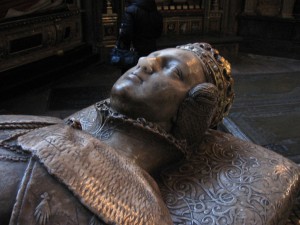
On 16th July 1517, St Francis’s Day, Frances Grey (née Brandon), Duchess of Suffolk, was born at Hatfield. She was the eldest daughter of Charles Brandon, Duke of Suffolk, and Mary Tudor, widow of King Louis XII of France and sister of Henry VIII.
Frances married Henry Grey, Marquis of Dorset (and later Duke of Suffolk), in 1533 and the couple had three children: Jane (Lady Jane Grey), who married Lord Guildford Dudley in 1553; Katherine, who married Edward Seymour, 1st Earl of Hertford, in 1560 (her first marriage to Henry Herbert was not consummated and was annulled); and Mary, who married Thomas Keyes, Sergeant Porter to Elizabeth I, in 1565.
Henry Grey and Lady Jane Grey were executed in February 1554, following Wyatt’s Rebellion, and Frances married Adrian Stokes, a member of her household, in March 1554. The couple had at least one child, Elizabeth, but none of them survived infancy. Frances died on 21st November 1559 at Richmond and was buried in St Edmund’s Chapel, Westminster Abbey, on the orders of her cousin, Queen Elizabeth I.
You can read more about Frances in Susan Higginbotham’s excellent article The Maligned Frances Grey and a list of facts about her in my article on her death – click here.
(Photo from Wikipedia.de)
A royal birth in a royal palace of a royal lady. Frances was not the monster that some historians have painted her and her tomb shows an elegant and fine woman. She was a good friend to Princess Mary and was able to come back into her favour after the death of her daughter Jane. Frances like many mothers of her blood and status must have been strict and had ambitions for her daughters, but I do not believe that the stories of her being cruel to Jane to force her to marry Dudley were true. Jane was a typical well educated noblewoman who knew her duty, just as her mother had done was to obey her parents and accept their choice of husband for her. It is a pity that her father went further and lost his head literally making a second rebellion when Jane was in the Tower, as this cost his daughter her life. Henry Grey was also very tall and handsome and clever, and he was most likely a good husband to Frances. Her baptism would have been magnificent as she was of course a royal niece and in line for the crown. Her pedigree however was a double edged sword and that was a shame for the Grey sisters.
Hatfield House is a beautiful place, as are the gardens, especially the older of the 2 buildings, can’t go in to see the old Royal Palace now but you can hire it for weddings etc.
I clicked on and read both articles, and was confirmed in my opinion that book-length biographies of minor historical figures are usually so lacking in facts and full of speculation that they are not worth reading.
After reading the comments on the articles I have one more thought. While I do not think Ascham’s account of Lady Jane Grey and her parents should be used as it has been by modern writers. Neither should it be entirely disregarded. Ascham was an experienced educator and would not have repeated those remarks if he thought they were just childish whining.